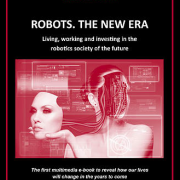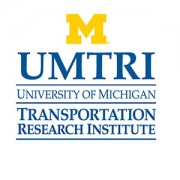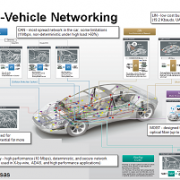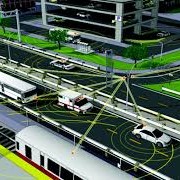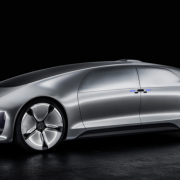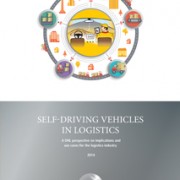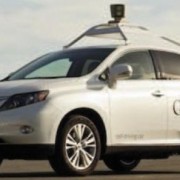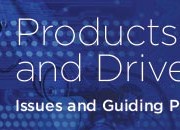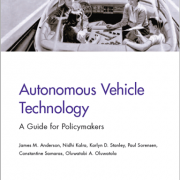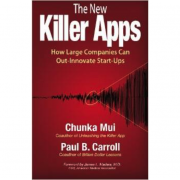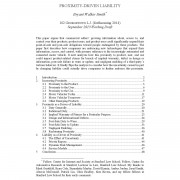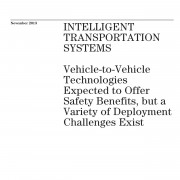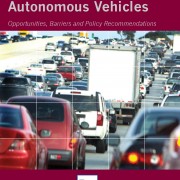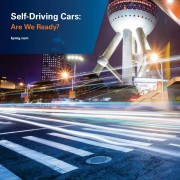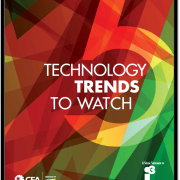Reports & Books
BMW, Intel and Mobileye Promise Autonomous Car Ridesharing Company Launch in 5 Years
/1 Comment/in Article, Consumer, Future, Industry, Insurance, Legal, Link Categories, News, Reports & Books, Technology, Technology Company, Transportation, Vehicle CompanyJennifer van der Kleut
In somewhat of a surprise move, BMW has announced it has developed a self-driving car that will be ready to hit the market in five years. Why is it a surprise? Because BMW has never mentioned working on the technology-while, meanwhile, everyone from Google to Tesla, Ford, General Motors and others have been making their […]
Robots, The New Era – Living, Working and Investing in the Robotics Society of the Future
/2 Comments/in Industry, Reports & Books, TechnologyAndrea Forni
This multimedia e-book by Andrea Forni is written for a general audience and helps readers understand what robotics is, and why it’s going to lead to a radical change in how millions of people live, work and invest in the stock market. A large portion of the book is devoted to autonomous vehicles for civil and […]
Potential Impact of Self-Driving Vehicles on Household Vehicle Demand and Usage
/in Reports & BooksThe University of Michigan Transportation Research Institute, sponsored by the University of Michigan Sustainable Worldwide Transportation, released this study by Brandon Schoettle and Michael Sivak.
Self-Driving Features may be Worth $42 Billion by 2025
/in Consumer, Economics, Future, Impact, Reports & Books, Technology, TransportationBoston Consulting Group
Partially Autonomous Vehicles Are Likely to Hit the Roads in Large Numbers by 2017; One-Fifth of U.S. Drivers Say They Would Pay More Than $5,000 Extra for Features Such as Highway or Urban Autopilot, BCG Study Finds.
FTC Reports on Security, Connected Vehicles and the IoT
/2 Comments/in Article, Reports & BooksBurney Simpson
Connected vehicles are part of a new report from the Federal Trade Commission focusing on privacy and security of the businesses and consumers that use the Internet of Things (IoT).
Connected Vehicles — 250 Million by 2020
/3 Comments/in Article, Consumer, Economics, Future, Impact, Industry, Insurance, Legal, Reports & Books, Technology, TransportationBurney Simpson
There could be as many as 250 million connected vehicles on roads worldwide by 2020, impacting telematics, automated driving, infotainment, and mobility services, according to the research firm Gartner Inc.
Automated Vehicles: The Coming of the Next Disruptive Technology
/in Reports & BooksThe Conference Board of Canada
The Conference Board of Canada’s report “Automated Vehicles: The Coming of the Next Disruptive Technology” predicts massive savings in lives and money in Canada from the changes wrought by driverless vehicles. The Board and its partner CAVCOE write that the rollout of this technology “will be disruptive to both the public and private sector. … Governments and businesses must begin to plan for the arrival of AVs sooner, rather than later. This report provides an overview of the potential benefits of AVs and highlights some of the issues that we need to start planning for.”
Road Safety with Self-Driving Vehicles: General Limitations and Road Sharing with Conventional Vehicles
/2 Comments/in Reports & BooksMichael Sivak and Brandon Schoettle
A new report from the University of Michigan Transportation Research Institute offers a review of some of the safety aspects of driverless vehicles as predicted by proponents of the technology.
DHL: Self-Driving Vehicles in Logistics
/in Future, Impact, Reports & Books, TransportationDHL
This trend report examines the distance that needs to be covered before self-driving technology reaches full maturity, and addresses the challenges of regulations, public acceptance, and issues of liability. It also shines the headlights on various best-practice applications across several industries today, and takes a detailed look into the existing technology that’s successfully used today […]
ANPRM and Supporting Report on Vehicle-to-Vehicle (V2V) Communications Technology
/in Reports & Books, Technology, TransportationNHTSA
The U.S. Department of Transportation’s (DOT) National Highway Traffic Safety Administration (NHTSA) today released an advance notice of proposed rulemaking (ANPRM) and a supporting comprehensive research report on vehicle-to-vehicle (V2V) communications technology. The report will include analysis of the Department’s research findings in several key areas including technical feasibility, privacy and security, and preliminary estimates on costs and safety benefits, while the ANPRM seeks public input on these findings to support the Department’s regulatory work to eventually require V2V devices in new light vehicles.
Autonomous Vehicle Implementation Predictions
/in Future, Reports & BooksVictoria Transport Policy Institute
This report explores the implications of autonomous (self-driving) vehicles on transportation planning. It identifies their potential benefits and costs, predicts their likely development and deployment patterns, and how they will affect transport planning decisions such as road and parking supply and public transit demand.
Products Liability and Driverless Cars: Issues and Guiding Principles for Legislation
/in Legal, Reports & BooksJohn Villasenor
This paper provides a discussion of how products liability law will impact autonomous vehicles, and provides a set of guiding principles for legislation that should —and that should not—be enacted. In some very specific, narrow respects, state-level legislative clarity regarding autonomous vehicle liability can be beneficial. Vehicle manufacturers that sell non-autonomous vehicles, for example, should not be liable for defects in third-party vehicle automation systems installed in the aftermarket. But broad new liability statutes aimed at protecting the manufacturers of autonomous vehicle technology are unnecessary.
The CNN 10 Future of Driving
/in Future, Reports & BooksCNN
Fully self-driving cars remain some years away. But new technology in the next five to 10 years will help cars park themselves, monitor the alertness of the driver and even communicate with each other to avoid collisions. Tomorrow’s cars may have long-range headlights, external airbags and hydrogen fuel-cell engines that emit only water. With this project, CNN is honoring 10 innovations in automotive tech. Some of these may gain traction quickly, while others may spin their wheels in the marketplace. But all have the potential to change how we drive in a good way.
Autonomous Vehicle Technology
/in Future, Reports & BooksRand Corporation
For the past hundred years, innovation within the automotive sector has created safer, cleaner, and more affordable vehicles, but progress has been incremental. The industry now appears close to substantial change, engendered by autonomous, or self-driving, vehicle technologies. This report is intended as a guide for state and federal policymakers on the many issues that this technology raises.
The New Killer Apps: How Large Companies Can Out-Innovate Start-Ups
/in Future, Impact, Reports & BooksChunka Mui, Paul B. Carroll
The New Killer Apps reverses the conventional wisdom that start-ups are destined to out-innovate big, established businesses. Through crisp analysis and compelling case studies, Mui and Carroll show that this just isn’t true. Or, at least, it need not be. Yes, small and agile beats big and slow, but big and agile beats anyone. This book offers a roadmap for how large companies can Think Big, Start Small and Learn Fast. In doing so, they can get out of their own way, take advantage of their natural assets, and vanquish both traditional competitors and upstarts by nurturing and unleashing their own killer apps.
Proximity-Driven Liability
/in Legal, Reports & BooksBryant Walker Smith
This working paper argues that commercial sellers’ growing information about, access to, and control over their products, product users, and product uses could significantly expand their point-of-sale and post-sale obligations toward people endangered by these products. The paper first describes how companies are embracing new technologies that expand their information, access, and control, with primary reference to the increasingly automated and connected motor vehicle. It next analyzes how this proximity to product, user, and use could impact product-related claims for breach of implied warranty, defect in design or information, post-sale failure to warn or update, and negligent enabling of a third-party’s tortuous behavior. It finally flips the analysis to consider how the uncertainty caused in part by changing liability could actually drive companies to further embrace this proximity.
Intelligent Transportation Systems: Vehicle-to-Vehicle Technologies Expected to Offer Safety Benefits, but a Variety of Deployment Challenges Exist
/in Reports & Books, TechnologyThis is a very good introduction to what is happening with the DOT and connected vehicles.
Preparing a Nation for Autonomous Vehicles: Opportunities, Barriers and Policy Recommendations
/in Future, Reports & BooksENO Center for Transportation
This paper focuses on the changes and benefits autonomous vehicles could bring to the nation’s transportation system. Barriers to implementation, liabilities, security and data privacy are also discussed, as well as the impacts and interactions with other components of the current transportation system.
Self-Driving Cars: Are We Ready?
/in Future, Reports & BooksKPMG
This is a follow-up to the 2012 report. In this report, KPMG went directly to consumers to ask the all-important question: If self-driving vehicles were available and safe, would you use them?
5 Technology Trends to Watch in 2014
/in Economics, Reports & BooksCEA
CEA, the group that hosts the CES show each January lists 5 technologies they believe will make a big impact starting in 2014.

